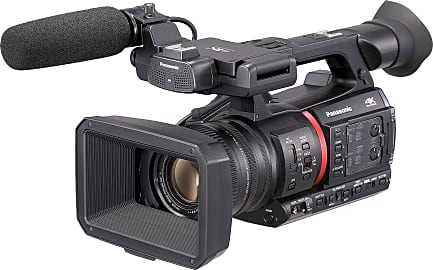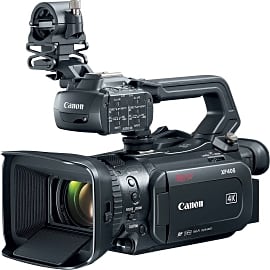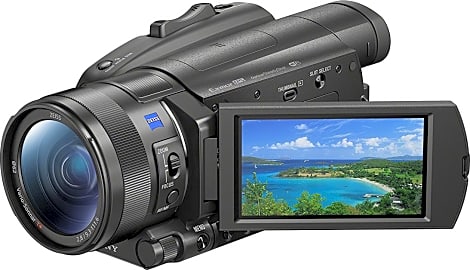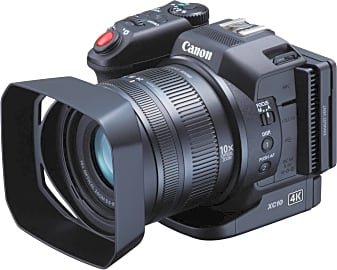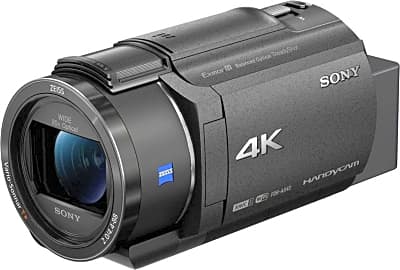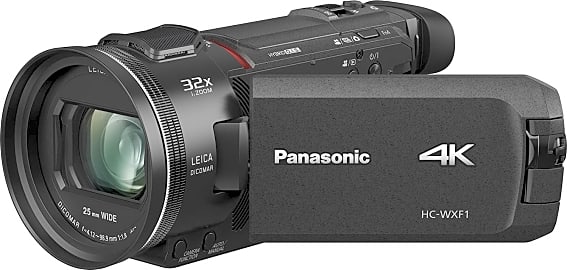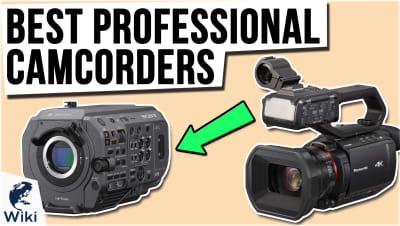The 10 Best 4k Camcorders

This wiki has been updated 38 times since it was first published in May of 2015. Whether you're a budding filmmaker, a video hobbyist, or just a parent who wants to capture the magical moments of your family's life in as much detail as possible, a 4K camcorder can enable you to make outstanding movies. Our selection includes models for just about every budget, and has been ranked by available features, image quality, ergonomics, and overall value. When users buy our independently chosen editorial picks, we may earn commissions to help fund the Wiki.
Editor's Notes
July 10, 2020:
The camcorder industry hasn't exactly been booming in recent years, and most of the major manufacturers are putting their R&D resources elsewhere, though it is good to see continued efforts from a few companies, like Sony, even as their mirrorless DSLRs dominate that sector. They've relatively recently put out the Sony FDR-AX43 UHD, which isn't particularly groundbreaking, but that has a handful of modern features most users would appreciate, like a 180-degree rotation for its viewscreen and the option to edit movies in-camera. We also added a new JVC model aimed at consumers in the JVC Everio GZ-RY980H. As with the Sony, anyone thinking about getting serious with their videography will upgrade from this eventually, but for a family looking for a durable camera that they can use for years without the video looking outdated, it's a great choice.
The top of this sector moves even more slowly, with offerings like Sony's FS series being among the most expensive and most entrenched models out there. The Sony PXW-Z280 Compact will get you close to that level of broadcast or cinema quality without the hassle of interchangeable lenses, and with a lighter weight and lower profile than the top dogs. That said, similar quality can be found in offerings like the Panasonic AG-CX350, though admittedly you'll have more latitude with color correction when editing footage from the Sony due to its array of three color-dedicated CMOS chips.
May 21, 2019:
Among the notable upgrades to models in our previous ranking, Sony has come out with two new models in their professional PXW lineup. The Z190 combines a trio of 1/3-inch sensors to essentially create a 1-inch chip, but despite being particularly feature-rich, its low-light performance still struggled enough to keep it out of the top three. In the end, it's likely that the size of its sensors, even when stacked and combined, was too small to achieve great footage in poor lighting. The Z190's big brother, however, the Z280, solves this by combining three 1/2-inch chips for a much larger detection area. It also outputs 4K at 4:2:2 and 10-bit color, where the Z190 only hits those benchmarks in 1080.
Elsewhere, the Canon XF 405 slid into the top three after proving itself to be as durable as it is capable. And farther down the list, our old nod to the off-brand camcorder market, the RainbowDay CC534K, was sent packing specifically for durability reasons, and was replaced with the somewhat more robust Zohulu Ultra HD, which comes with a nice little package for vloggers to stabilize the body and pick up decent audio.
The Fight Against Phony 4K
Another reason brings us to the other size-based difference between your phone’s 4K and that of the camcorders on our list.
In the early days of personal video recording, one might have seen a few tech-savvy parents at the school talent show equipped with camcorders that were absolute monstrosities. These video cameras shot on full-sized VHS tapes, which necessitated large housings, bulky motors, and more. At the time, this was cutting-edge stuff, and the people who owned the devices were at the forefront of a very real desire to capture our memories in the highest possible fidelity.
Today, that fidelity of 4K, there’s an enormous amount of difference between capturing a 4K video on your smartphone and recording at the same resolution on a 4K camcorder. And while the trend since the days of those behemoth video cameras has been to make everything about our technology smaller, the fact that these cameras outsize your cell phone is the very thing that makes them superior.
Let’s start by examining one of the more obvious external size differences: the lens. Go ahead and take a look at the lens on your cell phone camera. Its diameter is probably that of a pea. Compare that to even the smallest of the lenses mounted on the camcorders on our list, and inevitable feelings on inadequacy begin to arise. Any astronomer will tell you that one of the most important specs on a good refracting telescope is the size of its front lens element, which they often refer to as the light collecting area. The bigger the element, the more light that can reach the sensor at any given moment, making for better image quality, particularly in low light. Ever wonder why your cell phone takes such miserable pictures in the dark? This is one reason.
Another reason brings us to the other size-based difference between your phone’s 4K and that of the camcorders on our list. Behind that tiny lens on your phone is an even smaller sensor. Sure, it contains just as many pixels as the sensors in these bigger cameras, but those pixels have to be that much smaller to fit on such a little sensor.
It’s important to think of pixels like buckets. Each time you expose your sensor to light, the buckets fill up. The larger sensors, like those in these camcorders, can absorb more light energy. The smaller buckets on your smartphone sensor can absorb far less energy. Less light always makes for a lower quality image.
Finally, if you’re a filmmaker, or you simply prefer to have direct and easy access to a number of adjustments as you shoot, you need a good camera. Sure, there are a few apps that give you power over aperture, shutter speed, focus points, etc. while shooting with your phone, but these all necessitate interactions with your phone’s screen that inevitably disrupt your shot. With a good camcorder, you can make adjustments on the fly, even in the middle of a shot, without jostling the frame.
Know Thyself; Know Thy Camera
There are rare instances in the world of high-end consumer electronics where paying more money doesn’t get you a better product, so spending toward the top of your budget on a camcorder is usually a good bet. Just make sure you leave enough room for memory cards, extra batteries, a case, etc.
Again, though, if you’re just trying to capture your family’s memories in as high a resolution as possible given today’s technology, this is a feature you can easily bypass.
The other thing about a camcorder purchase is that you want to make sure you aren’t paying for features that you’re never going to use. For example, some camcorders include a kind of shield around the front of the lens. In some cases, it merely makes the lens itself look recessed into the body of the camera, while other shields resemble the professional matte boxes you see in the film industry.
These matte boxes work wonders in highly lit areas where light sources would otherwise cause visible and unattractive lens flare in your image. Of course, if all you really shoot are family interiors like birthday parties, as well as the occasional kids’ sports game, you probably don’t have to worry too much about lens flare.
The best of these camcorders also offer manual focus controls. If you’re serious about gaining proficiency as a videographer, perhaps going so far as to sell your services at weddings or similar events, you’ll want the added level of control that manual focus provides, so long as you have the patience to get good at it. Budding filmmakers should also demand that their cameras have manual focus controls, as your focal plane is a big part of your storytelling. Again, though, if you’re just trying to capture your family’s memories in as high a resolution as possible given today’s technology, this is a feature you can easily bypass.
If you’re picking up on a trend here, it’s not in your imagination. As the prices of these cameras go up, the models begin to cater more toward amateur filmmakers and budding professionals than to the common parent with a bent toward high-tech memories. The exact placement of that line will depend on the individual, though, so put a little thought into the kind of shooter you want to be, and start your selection from there.
From Whence 4K Came
With most innovations in the resolution of digital imagery, capturing methods far outpace the means for display. Around the time that HDTVs capable of displaying images in 1080p began to become a mainstay in the homes of average Americans, a specialty electronics company in Canada brought the first camera with 4K capture to market.
The DALSA Corporation, best known perhaps for the imaging sensor technology that they developed for a number of NASA’s Mars rovers, produced a camera with a 4096×2048 resolution that they unveiled at the NAB Show in Las Vegas in 2003. They called it the Origin.
Just two years after that, Netflix had a hit on their hands with House of Cards, a show shot entirely on Red’s 4K cameras.
It would be more than a decade before more established camera companies produced consumer cameras equipped with the kind of resolution and dynamic range that the DASLA Origin provided. The linear exposure latitude alone was worth more than 13 stops, meaning that, in addition to showing more detail in a sharper image, the Origin was capable of gathering more light information from shadowy and over-lit areas of a frame alike.
At this point in the film industry, digital capture had barely established itself as a feasible means of production. Thanks largely to a company called Red, however, the quality of digital video soon matched that of film to the point where seasoned filmmakers could barely tell the difference. By 2011, enough movies were being shot digitally that 4K projection began to make its way into theaters. Just two years after that, Netflix had a hit on their hands with House of Cards, a show shot entirely on Red’s 4K cameras. Around this time, the prices of 4K televisions began their steady decline, and Netflix soon announced plans to stream content in 4K, while Red announced cameras capable of capturing video in 6K and 8K.
You'll often see a lower case 'i' or 'p' after the 1080 on cameras and displays, or after a number indicating available frames per second, like 30, 60, 120, or 240 on camera spec sheets. These little letters stand respectively for interlaced and progressive, and I'm going to save you a lot of time here:
You want to shoot with the 'p'. Progressive scanning TVs are significantly more common than interlaced monitors, and an interlaced video displayed on a progressive screen looks like it's strung with a couple dozen thin, black horizontal lines, like the Hamburgler.



